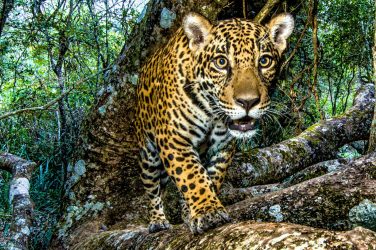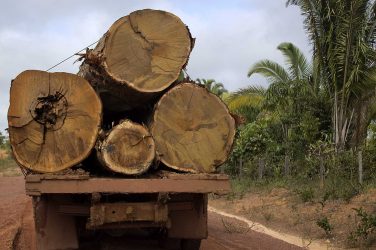Beef production has become a major driver of tropical deforestation, responsible for as much as 65 percent of rainforest destruction caused by the global agricultural commodities trade in the first decade of the 21st century, according to a 2015 study.
The Yale School of Forestry and Environmental Studies’ Global Forest Atlas states that cattle ranching is the largest driver of deforestation in all Amazonian countries, responsible for as much as 80 percent of current deforestation.
About 450,000 square kilometers of land has been deforested in the Brazilian Amazon alone, turned into cattle pasture in order to accommodate a herd of more than 200 million head of cattle.
One proposed means of slowing the rate at which forests are being destroyed to create pastureland for cattle in the Amazon and other tropical regions is intensification, or the adoption of technologies and practices that allow for the production of more beef on less land, together with a greater focus on supply chain management as a means of preventing unsustainably produced beef from making it to market, inasmuch as possible.
But in a commentary published in the journal Elementa, researchers Frank Merry of the Washington, D.C.-based NGO Conservation Strategy Fund and Britaldo Soares-Filho of the Center for Remote Sensing at the Federal University of Minas Gerais in Brazil argue that this “solution” may actually have it exactly backwards: intensification does not lead to desired conservation outcomes, they contend, but certain conservation measures can spur cattle ranchers to sustainably intensify production.
“Based on a historical comparison between the US, a fully intensive system, and Brazil, one moving in that direction, we suggest that cattle ranching will intensify as a result of conservation investments (reductions in capital and land subsidies) rather than intensifying in order to produce conservation results,” the researchers write in the article.
In other words, they make the case that “seeking positive conservation outcomes by increasing beef productivity and engaging directly with the supply chain may be a flawed approach and that the opposite could be true — i.e., conservation outcomes such as removing land from production, better oversight of land use, or improved enforcement will further catalyze intensification.”
Merry and Soares-Filho based their argument on a review of the existing literature examining the U.S. beef industry and their own previous work with the Brazilian ranching sector, which they detail in the paper as “including a recent cost benefit analysis of ranching (Barbosa et al., 2015), extensive field work in development of models of the cattle sector (Bowman et al., 2012), and work in conjunction with local non-profits, such as Aliança da Terra.”
The researchers found clear historical and contemporary similarities in how beef is produced in the U.S. and Brazil, leading them to conclude that cattle intensification will likely occur “independently and organically” in Brazil, as it has in the U.S.
The adoption of intensification measures could be further accelerated in the South American country, Merry and Sores-Filho note, if Brazil were to address the “institutional failures” that have encouraged deforestation and other unsustainable ranching practices, such as policies that make ranching the most cost-effective means of establishing land tenure in the country and development incentives like tax breaks, frontier settlement programs, and subsidized credit that promote the expansion of pastureland.
Even as the U.S. beef industry has intensified, beef has lost market share to other forms of protein (mostly chicken and pork) and the cattle herd has shrunk by 30 percent over the past 40 years, the researchers found. Yet the industry continues to require large natural resource inputs and significant government subsidies, while still generating “considerable negative environmental externalities.”
Beef production in Brazil may very well follow a similar path, they write: “In which case, the Brazilian sector will intensify and shrink as a result of policies that remove land from production and see an increase in the price of beef relative to other protein sources, thus dampening demand through competition.
However, with intensification focusing on feedlots and fattening steers, the impact may not be significant in reducing the overall herd population.” The researchers therefore infer that “intensifying beef production may have few or no attributable conservation outcomes, but instead holds the potential to simply redirect negative externalities.”
The researchers recommend that policymakers in Brazil “focus on causes, not symptoms,” by taking a closer look at how credit, land tenure, illegal land use, and infrastructure contribute to the expansion of cattle ranching into forested areas. They also recommend strengthening existing measures for the preservation of forests, such as protected areas, indigenous land titling, and multiple-use forests.
“There is also a growing argument for closing the frontier, as the U.S. did in 1892, and halting the settlement programs, which would have the effect of making land scarce,” they add.
“These recommendations are not new, but relevant in the face of numerous publications suggesting there is direct conservation benefit to be gained by increasing beef productivity and managing the beef supply chain.”
In the end, however, the researchers determine that some environmental degradation for cattle ranching is unavoidable, given our increasing appetite for beef. Even “efficient” beef produced in the U.S. requires 28 times the land, consumes 11 times the water, and produces five times the greenhouse gases as other livestock. It’s possible, they say, that the only way the production of beef can ever lead to positive conservation outcomes is if we simply consume less of it.
“The inescapable truth of beef production is that it is one of the least efficient transformations of energy into consumable calories,” they write, “and whether driven by government policy, markets or custom, the increasing consumption of beef worldwide will undoubtedly have significant environmental impact.”
Notes:
Barbosa, F., Soares-Filho, B., Merry, F., Azevedo, H., Coe, M., Batista, E., Maciel, T., Oliveira, A., & Rodrigues, H. (2015). Cenários para pecuária de corte amazônica. Instituto de Geociências da Universidade Federal de Minas Gerais, p. 146.
Bowman, M.S., Soares-Filho, B.S., Merry, F.D., Nepstad, D.C., Rodrigues, H., & Almeida, O.T. (2012). Persistence of cattle ranching in the Brazilian Amazon: A spatial analysis of the rationale for beef production. Land Use Policy, 29: 558–568. doi:10.1016/j.landusepol.2011.09.009
Henders, S., Persson, U. M., & Kastner, T. (2015). Trading forests: land-use change and carbon emissions embodied in production and exports of forest-risk commodities. Environmental Research Letters, 10(12), 125012. doi:10.1088/1748-9326/10/12/125012
Merry, F., & Soares-Filho, B. (2017). Will intensification of beef production deliver conservation outcomes in the Brazilian Amazon? Elem Sci Anth, 5. doi:10.1525/elementa.224
Follow Mike Gaworecki on Twitter: @mikeg2001
This article appeared originally in Mongabay – https://news.mongabay.com











